Whiteflies in greenhouse crops: biology, damage and management
Learn about the life history, damage caused, and management strategies for whiteflies in greenhouse crops.
Introduction
Whiteflies are a major pest of greenhouse crops, including tomatoes and cucumbers, as well as many ornamental species, such as poinsettia, gerbera and a number of spring crops. Many weed species are also hosts of whiteflies and often serve as sources of infestations.
Description and life history
Adult whiteflies are small, winged, white insects about 1.5-2 mm long (Figures 1 and 2). Eggs are laid on the underside of the youngest leaves and are too small to be seen clearly without a microscope (Figures 3a and 3b). A female whitefly may lay up to 300 eggs during her lifetime and live as long as 42 days at 18°C and 8 days at 27°C.
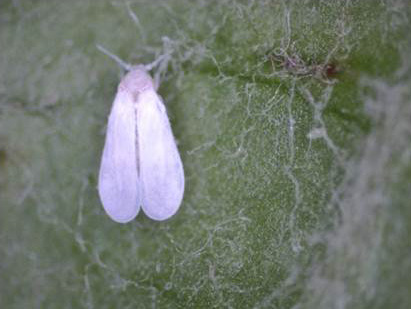
Figure 1. Adult greenhouse whitefly.
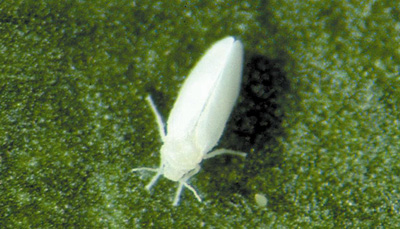
Figure 2. Adult Bemisia.
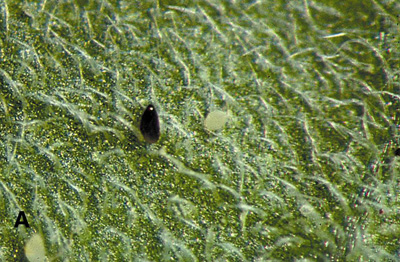
Figure 3a. Recently laid (lighter coloured) and more mature (darker) eggs.

Figure 3b. Circular egg-laying pattern of greenhouse whitefly on some crops.
After hatching, the eggs undergo four stages, or instars, before becoming adults. The first instar, or nymphal stage, hatches in 5-10 days (Figure 4). Sometimes called crawlers, whiteflies at this stage are flat and scale-like and crawl around for a short while before becoming immobile. The second and third nymphal stages are followed by the fourth, or pupal, stage. The adult emerges from the pupal stage (Figures 5a and 5b). Old pupal skins and adults may be found on the underside of lower leaves, which may have symptoms of wilt.
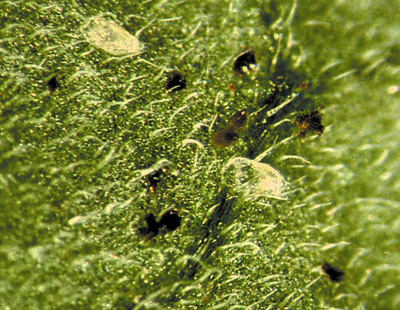
Figure 4. Early larval stage recently hatched from egg.
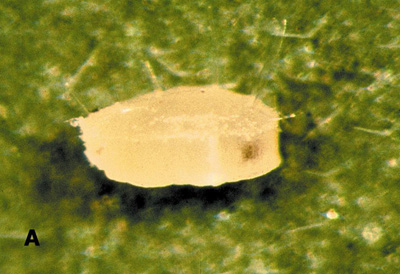
Figure 5a. Pupa of greenhouse whitefly.
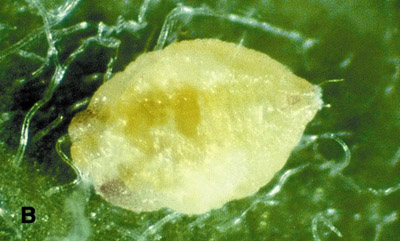
Figure 5b. Pupa of Bemisia.
On average, the whitefly completes its life cycle in 35 days at 18°C and 18 days at 30°C. Whiteflies have no special overwintering stage and can usually survive as long as there is some kind of vegetation around.
Whitefly species
There are two whiteflies of concern to growers in Ontario: the greenhouse whitefly (GWF) (Trialeurodes vaporariorum) (Figure 1) and Bemisia (Figure 2). There are actually two Bemisia species: Bemisia tabaci, also known as sweetpotato whitefly, and Bemisia argentifolii, also known as silverleaf whitefly. Because the two species cannot be easily differentiated, they are simply referred to as Bemisia in this factsheet.
Although the GWF and Bemisia adults look very similar, there are some differences. Bemisia is slightly smaller than GWF, and its body is more yellow in colour. At rest, Bemisia holds its wings in a tent-like position above its body, whereas GWF holds them flatter and more parallel to the surface on which it is resting.
The major diagnostic differences between GWF and Bemisia occur in the pupal stages. The GWF pupa (Figure 5a) is raised off the leaf surface and is surrounded by a fringe of hairs. In contrast, the Bemisia pupa (Figure 5b) sits flat on the leaf and does not have a fringe. These features are best seen with a microscope. In addition:
- Bemisia flies in a more direct manner whereas GWF flies in a more haphazard pattern
- the life cycle of Bemisia takes longer to complete
- Bemisiais less adapted to cold conditions
Pest status
Whiteflies cause damage in a number of ways:
- Their piercing-sucking mouthparts allow them to remove sap from the plant, causing a reduction in plant vigour.
- They excrete large amounts of a sugary substance called honeydew (Figure 6a). Honeydew promotes the growth of a black sooty mould (Figures 6b and 6c) on plant surfaces. Although the sooty mould itself does not damage the plants, it reduces photosynthesis and crop quality.
- They can transmit viruses. For example, Bemisia is reported to transmit over 60 viruses, and GWF has been linked with the spread of beet pseudo-yellows virus (Figure 7) in cucumbers.
- In ornamental crops, their presence and easy visibility make the plants less attractive (Figure 8).
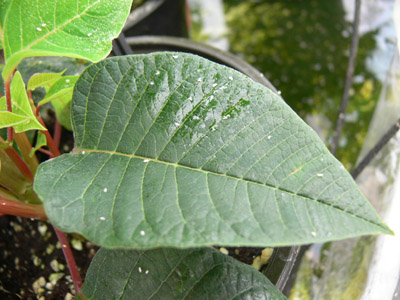
Figure 6a. Honeydew residue on poinsettia.
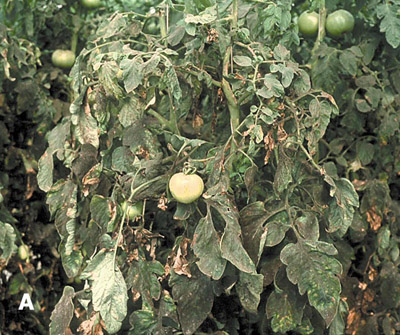
Figure 6b. Sooty mould on tomato.
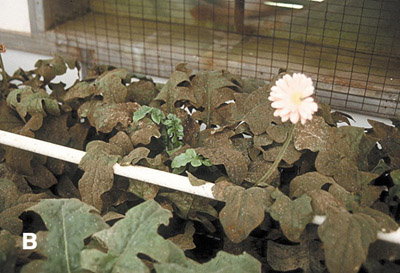
Figure 6c. Sooty mould on gerbera.
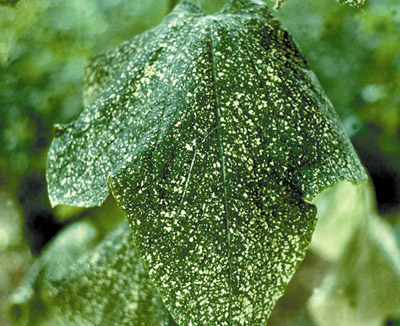
Figure 7. Pseudo-yellows disease on cucumber.
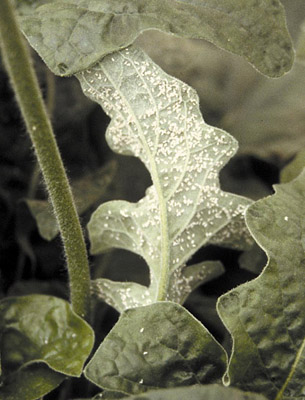
Figure 8. Large numbers of whiteflies reduce the quality and marketability of ornamental crops.
Management strategies
General recommendations
- Implement a routine monitoring program using yellow sticky cards and plant inspections.
- Use host plants that are more attractive to whiteflies than the main crop as an early detection tool or as a trap plant (for example, eggplant or tobacco).
- Mark infested plants so they can be used as indicators of the success of control strategies.
- React promptly when whitefly adults are observed either on cards or on terminal leaves.
- Identify the whitefly species present on the crop.
- Maintain good weed control.
- For infected vegetable crops, quarantine new seedlings, transplants or cuttings until it is clear they are virus-free.
Biological control
There are currently a number of commercially available biological control agents for whiteflies:
- Three parasitic wasps: Encarsia formosa, Eretmocerus eremicus and Eretmocerus mundus
- a small black ladybeetle, Delphastus catalinae
- a predatory bug, Dicyphus hesperus
Additionally, there are two microbial products, Beauveria bassiana and Isaria fumosorosea, that are fungal pathogens of whiteflies.
Encarsia formosa
Encarsia is more effective against GWF but will still provide some control of Bemisia. Adult Encarsia are about 0.6 mm long and have a black thorax and yellow abdomen (Figure 9a). They kill whiteflies mainly by laying eggs into the immature stages (mostly the third and fourth instars). Adult Encarsia can live for a few days to a month depending on temperature. Females lay 50-350 eggs during their lifetime.
GWF pupae turn black 10-14 days after being parasitized (Figure 9b). On average, another 2 weeks are needed before the adult wasp emerges. When the adult is fully developed, it cuts an opening in the top portion of the black scale before emerging.
Parasitism by Encarsia of Bemisia is not as effective as in GWF. Parasitized Bemisia turn a tan to brown colour and are not as easily noticeable (Figure 9c). To control Bemisia with Encarsia, consider higher introduction rates.
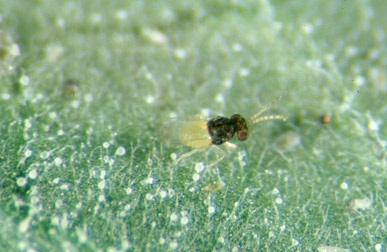
Figure 9a. Adult Encarsia formosa.
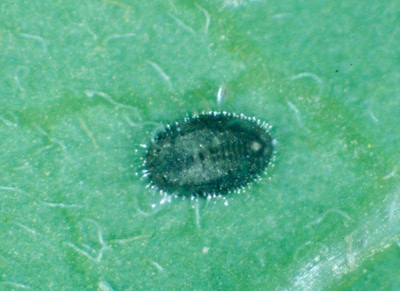
Figure 9b. Greenhouse whitefly pupa parasitized by Encarsia formosa.
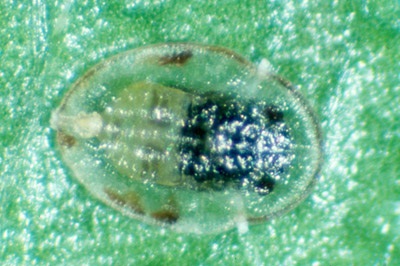
Figure 9c. Bemisia pupa parasitized by Encarsia formosa.
Success with Encarsia can be improved in a number of ways:
- Avoid using pesticides with long residual effects for at least 3 months before the initial release of Encarsia. Specific information on the side effects of pesticides on biocontrol agents is available from Biobest or Koppert or from an OMAFRA Greenhouse IPM Specialist.
- Monitor all stages of crop production to detect whiteflies and to track trends in their population levels. This allows for more accurate placement and timing of parasitoid releases.
- Introduce Encarsia at the first sign of whitefly, or use it preventively before whiteflies are detected. Before the release of Encarsia, it may be necessary to reduce the population of whiteflies with a low-residual pesticide if they are present.
- Avoid using Encarsia between December and February unless light and temperature conditions are adjusted to suit the parasitoid.
- Distribute Encarsia in shaded parts of the plant where the parasitoids are protected from direct sunlight.
- Distribute cards relatively evenly, but place more in areas where whiteflies are observed. Purchase cards with fewer parasitized scales per card to achieve more distribution points.
- Avoid removing leaves with immature parasitized scales during deleafing or pruning operations. Removing them slows the build-up of Encarsia numbers and parasitism rate.
- Continue introducing Encarsia in vegetable crops until at least 80% of the scales on older leaves are black. During the warmer months, when whiteflies move into the greenhouses from outside, introductions may have to be maintained or increased.
Eretmocerus eremicus and Eretmocerus mundus
E. eremicus parasitizes both GWF and Bemisia, while E. mundus is specific to Bemisia. Adult Eretmocerus resemble Encarsia in shape and size but are entirely yellow (Figure 10a). Although this wasp species will host feed on all four whitefly instars, it prefers to parasitize second and third instars. Adults live for 1-2 weeks and lay approximately 100 eggs during their lifetime. The majority of these eggs are laid within the first 6 days after emerging from their pupal cases. Because this wasp thrives at higher temperatures than Encarsia, they are best released later in the year, around March.
Parasitized whiteflies are a slightly different colour from those that are not parasitized, but this difference is not as noticeable as it is with Encarsia (Figure 10b and 10c). Tips for increasing success with this parasitoid are similar to those listed for Encarsia. Eretmocerus is very attracted to yellow sticky cards and tape, so it may be necessary to reduce the use of these tools, particularly when trying to establish an Eretmocerus population.
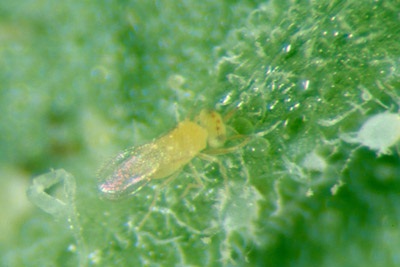
Figure 10a. Adult Eretmocerus eremicus.
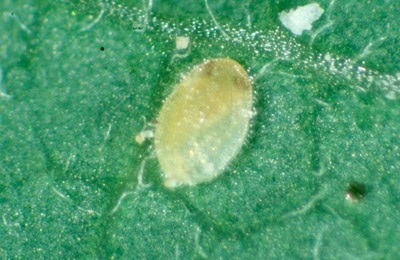
Figure 10b. Greenhouse whitefly pupa parasitized by Eretmocerus.
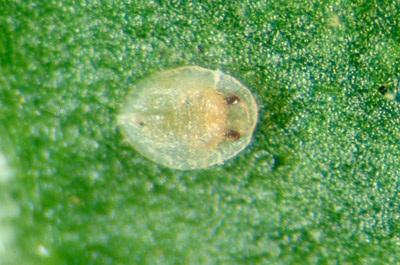
Figure 10c. Bemisia parasitized by Eretmocerus.
Delphastus catalinae
Both adult (Figure 11a) and larval (Figure 11b) Delphastus feed on whiteflies, particularly on the eggs and nymphs (however, they avoid parasitized scales). This behaviour makes them compatible with the use of parasitic wasps. Use these beetles to supplement the activity of parasitic wasps for reducing whitefly populations. Adult Delphastus live for 6-9 weeks and reportedly need at least 10 whitefly eggs per day to reproduce. Their need for large numbers of whitefly to sustain their development makes them more suited to crops with higher tolerances for whiteflies, such as vegetable crops or cut gerbera.
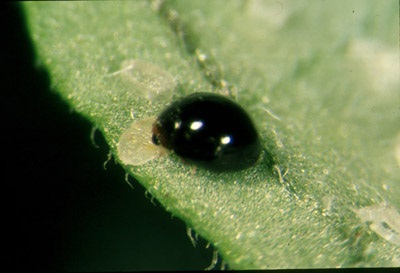
Figure 11a. Adult Delphastus catalinae feeding on whitefly larva.
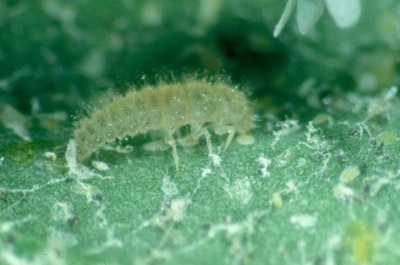
Figure 11b. Larva of Delphastus catalinae.
Dicyphus hesperus
Dicyphus (Figures 12a and 12b) is a predatory bug with piercing/sucking mouthparts. These bugs are general feeders. However, they appear to prefer whiteflies, feeding particularly on the eggs and larval stages. To a lesser extent, they feed on aphids, spider mites, thrips, leafminer larvae and moth eggs. In the absence of prey, a high population of Dicyphus may cause damage to tomato fruits and flowering crops such as gerbera. To manage whiteflies, it is best to use Dicyphus together with the parasitic wasps Encarsia formosa and Eretmocerus eremicus. The use of banker plants such as mullein (Verbascum thapsus) (Figure 12c) may help establish Dicyphus when whitefly population densities are low.
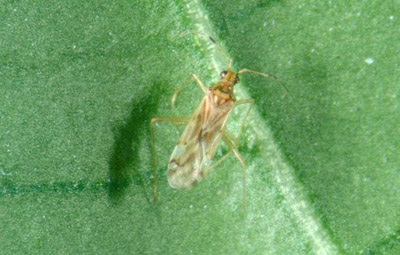
Figure 12a. Adult Dicyphus hesperus.
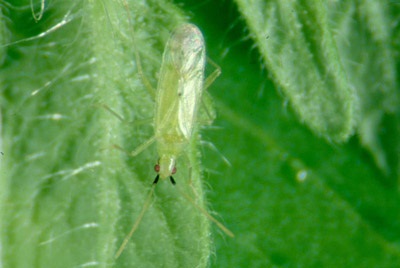
Figure 12b. Light-green, recently emerged adult Dicyphus.
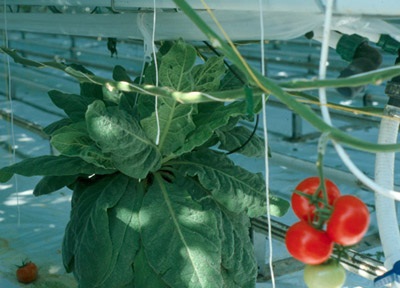
Figure 12c. Mullein banker plant in tomato crop.
Physical control
There are three forms of physical control for whiteflies.
- Sticky traps: Yellow sticky traps in various forms can be used to trap large numbers of adult whiteflies. Use large, yellow sticky boards or 30-cm yellow sticky tapes in "hot spots." Alternatively, drape large quantities of yellow sticky tape between posts along plant rows (Figure 13). These sticky traps will also attract thrips, fungus gnats, shore flies and parasitic wasps (especially under low whitefly populations).
- Vacuuming: Hand-vacuuming adults in "hot-spots" is very effective in rapidly removing adult whiteflies but is not cost-effective over large areas (Figures 14a and 14b).
- Insect barriers: Installing fine screens over vents and doorways significantly reduces the movement of outdoor populations into greenhouses. Where whiteflies move in from adjacent field crops (for example, field tomatoes) in large numbers at certain times of the year (for example, during harvest), consider screening as the first line of defence. See OMAFRA Factsheet Screening of greenhouses for insect exclusion.
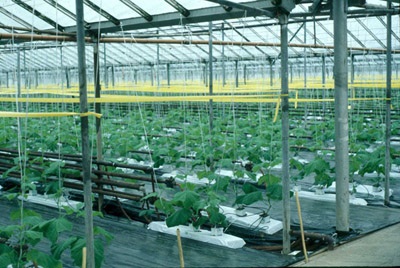
Figure 13. Use of yellow tapes for mass trapping.
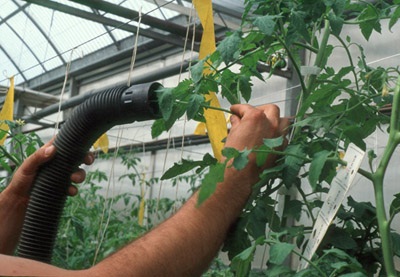
Figure 14a. Hand-vacuuming adult whiteflies in tomato crop.
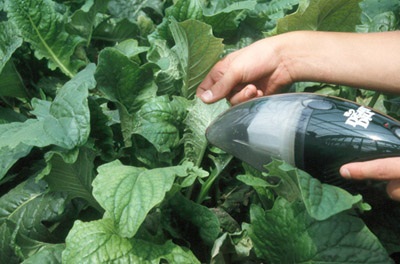
Figure 14b. Hand-vacuuming adult whiteflies in gerbera.
Chemical control
Whiteflies can develop resistance to many pesticides. Judicious use will extend the useful life of pesticides and delay build-up of resistance. Always use pesticides in conjunction with a regular monitoring program, using action thresholds and rotating chemical classes. At the same time, make use of all available control strategies.
For specific chemical control options, refer to OMAFRA Publication 370, Guide to Greenhouse Floriculture Production or OMAFRA Publication 835, Crop Protection Guide for Greenhouse Vegetables.